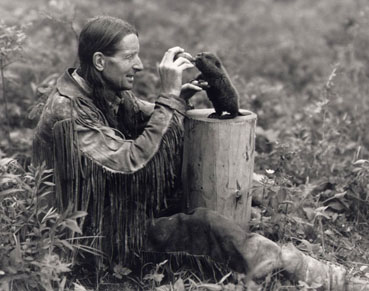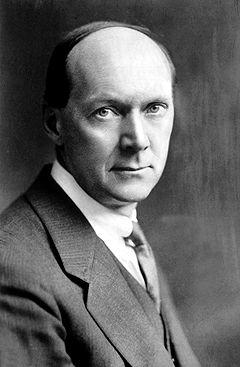Emily Pauline Johnson (a.k.a. Tekahionwake, “double wampum”) poet, writer, artist, performer (born 10 March 1861 on the Six Nations Reserve, Canada West; died 7 March 1913 in Vancouver, BC). Pauline Johnson was a notable 19th-century artist. Of Mohawk and European descent, she was a gifted writer and speaker. She toured widely, winning audiences over with her flare for the dramatic arts. Johnson is listed as a Person of National Historic Significance. Her childhood home is a National Historic Site and museum. A monument in Vancouver’s Stanley Park pays tribute to her work and legacy. In 2016, she was one of 12 women who were considered to appear on a banknote.
This article is a plain-language summary of Pauline Johnson (Tekahionwake). If you are interested in reading about this topic in more depth, please see our full-length entry: Pauline Johnson (Tekahionwake).

Early Life and Education
Pauline Johnson was born on the Six Nations Reserve near the Grand River at Chiefswood. It was southeast of Brantford in what is now Ontario. Chiefswood was the family home of Johnson and her three siblings from 1856 to 1884. Her father, George H.M. Johnson, worked at a nearby Anglican mission. He was an interpreter who helped the negotiations between the Mohawk, the British and the federal government.
Johnson suffered poor health as a child. She did not attend day school at the reserve like other Indigenous kids of the time. Instead, she received an Anglican education. When she was 14, she started going to Brantford Central Collegiate. She graduated in 1877.
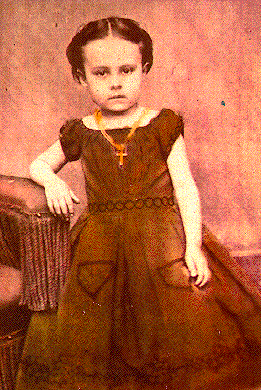
Family and Cultural Background
Pauline Johnson’s mixed-race identity was a huge part of her life. Her Mohawk name, Tekahionwake (“double wampum”), speaks to this. She was Haudenosaunee (Iroquois) and British. Her father was of Mohawk and European descent. Her mother, Emily Susanna Howells, was born in England. She immigrated to the US with her family as a small child. The Howells were known for their interest in literature. Emily and George married in 1853. George became chief of the Six Nations soon after. He was also a Crown interpreter for the Six Nations.
Johnson lived in an age of institutional racism. But she and her family enjoyed a privileged position in society. This was mainly due to her father’s status as a cultural go-between. Her parents hosted dignitaries, intellectuals and artists.
Johnson was taught to honour her Mohawk roots. She understood Kanyen'kéha, the Mohawk language. She was told many stories by her paternal grandfather, Chief John Smoke Johnson. His dramatic talents inspired Johnson’s work as a poet.
Johnson’s father passed away in 1884. She and her siblings then inherited some of the family’s Mohawk artifacts. Johnson used many of these items in her shows. These included wampum belts and masks.
Writing and Poetry
Pauline Johnson began writing poetry in her mid-teens. She was best known for her writings about Indigenous culture. She enjoyed great success during her lifetime. She was widely published in newspapers and magazines.
Johnson first had her poetry published in 1884. She soon began to recite her poems and stories for audiences. By 1895, she was at the height of her success as a performer. She released a volume of poetry, The White Wampum (1895). This was followed by Canadian Born (1903) and Flint and Feather (1912). In 1911, Johnson published Legends of Vancouver. It is a series of tales and short stories told to her by Squamish chief Joe Capilano. Two books of short stories were published after her death in 1913: The Shagganappi and The Moccasin Maker.
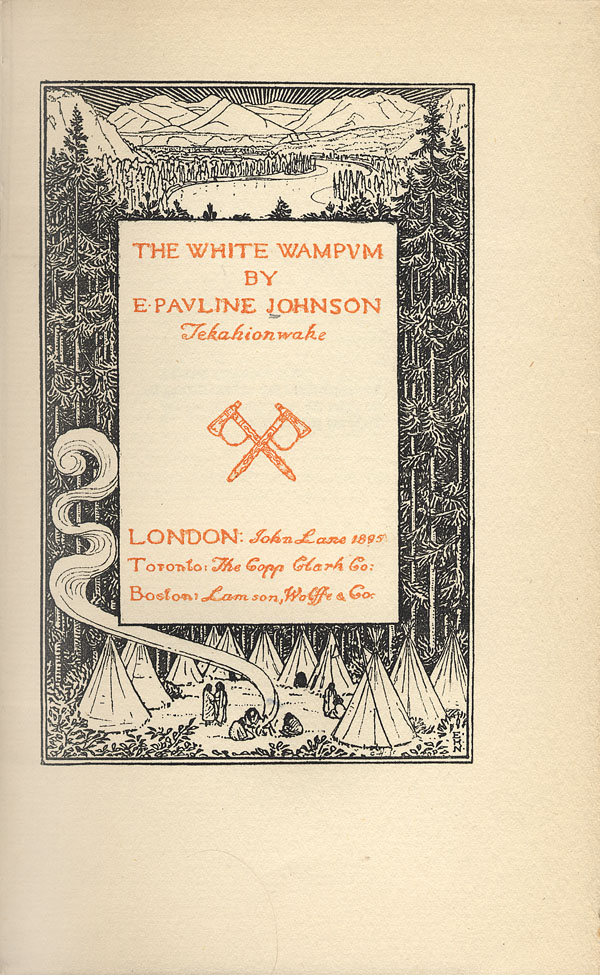
Speaking Tours
Pauline Johnson was in her early 20s when her father died in 1884. She moved to Brantford, Ontario, to be with her ageing mother and sister. She then pursued a career in spoken-word performances. She used the money she made publishing and touring to support herself and her family.
Between 1884 and 1909, Johnson toured Canada, the US and England. Her readings of patriotic poems made her popular. (See also Patriotic Songs.) She also found success performing her own poetry. She worked Indigenous items into her show. She would start her show in Mohawk dress, then change into Victorian clothing.
Influences
Much of Pauline Johnson’s career happened during a period of heightened nationalism following Confederation. Some of her poems were part of the anthology Songs of the Great Dominion (1889). It was one of the first books to include poetry by both French Canadian and Indigenous authors. Johnson was also loosely linked with the Confederation Poets in the 1880s. Their style tied a love of nature to the essence of being Canadian. Johnson was one of the first Canadian poets to write about camping and living in the wilderness.
Johnson also lived during a time of intense state regulation of Indigenous peoples. (See also: Indian Act; Reserves; Residential Schools.) Her status as a single and childless woman contributed to her poverty. This was despite her rise as a well-known poet and performer. It also happened amid calls by the women’s movement to expand roles for women.
Criticism
As a racialized and unmarried woman, Johnson’s choice to profit from her Indigenous background helped her survive poverty. Johnson spoke of herself as an Indian. But some critics have challenged this. They note that her adult life was spent away from Mohawk culture. She was somewhat removed from Indigenous people. Also, her poetry and performances were made to suit the tastes of White people. They typically held racist ideas about Indigenous peoples. Johnson’s shows drew heavily on the tropes of the “Indian Princess” and “noble savage” that are now severely outdated.
But Johnson also wrote critically about the stereotypes faced by Indigenous peoples during this time. She drew connections between racism, poverty and violence. For example, in “A Red Girl’s Reasoning,” she humanized Indigenous peoples at a time when mainstream views toward them were ignorant and racist. Johnson was also critical of the impact of Christianity on Indigenous ways of life.
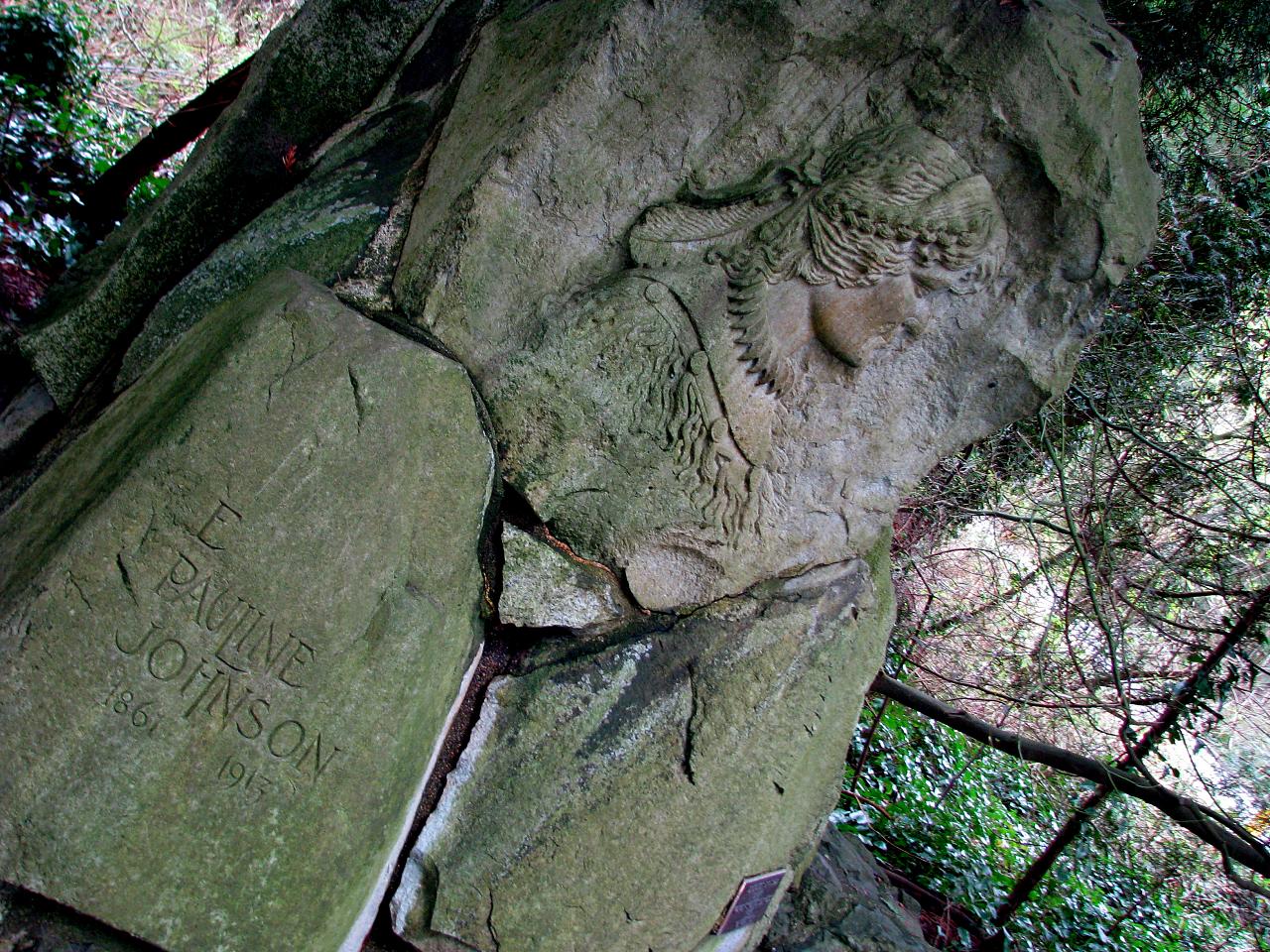
Legacy
Pauline Johnson spent the last years of her life in Vancouver. She died there on 7 March 1913, three days shy of her 53rd birthday. A monument in Stanley Park pays tribute to her work and legacy. She is also listed as a Person of National Historic Significance in Canada. Her childhood home, Chiefswood, is a National Historic Site and public museum. In 2016, the federal government announced that Johnson was one of 12 women being considered to appear on a new banknote. (See also Women on Canadian Banknotes.)
Johnson’s work was well received during her lifetime. It was largely forgotten in the decades after her death. By the latter half of the 20th century, there was renewed interest in her work. She made important contributions to Indigenous and Canadian oral and written culture. She continues to be seen as a talented literary figure.
See also: Vancouver Feature: Pauline Johnson Names Lost Lagoon; The Canadians: Pauline Johnson.

 Share on Facebook
Share on Facebook Share on X
Share on X Share by Email
Share by Email Share on Google Classroom
Share on Google Classroom



